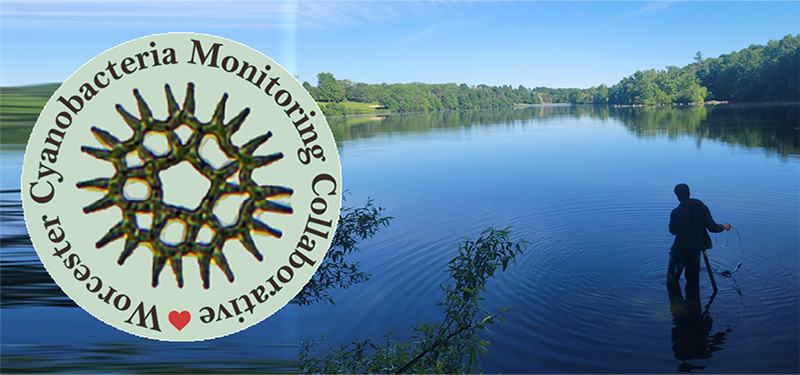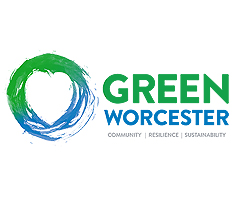

The Worcester Cyanobacteria Monitoring Collaborative (WCMC) is a group of volunteer community scientists that is working to better understand cyanobacteria in Worcester's lakes and ponds and the risk they pose to public health.
Latest Monitoring Results Volunteer Microscope Photos Volunteer Field Sheet
Cyanobacteria, also known as blue green algae, are naturally occurring microscopic organisms that use sunlight for energy. They are one of the oldest organisms on the planet, and found in almost every ecosystem in small numbers. However, under certain conditions, such as in warm, nutrient rich lakes, cyanobacteria can multiply very rapidly and cause "blooms". Blooms, in addition to potentially being unsightly and smelly, can cause low oxygen conditions in lakes when they die that can lead to fish kills. Additionally, when their population gets high enough, cyanobacteria are able to produce toxins that are harmful to humans and pets.
Depending on the species of cyanobacteria, these organisms have the potential to produce several different kinds of toxins, including hepatatoxins (affecting the liver), dermal toxins (affecting the skin), and/or neurotoxins (affecting the brain). Just because cyanobacteria are present, however, does not mean that toxins are being produced. Scientists are still learning the triggers for toxin production, but we do know that when there are higher concentrations of cyanobacteria, there is a greater chance that toxins will be present in harmful quantities. For that reason, it is important to avoid contact with water that have cyanobacteria advisories.
For more information on symptoms associated with cyanotoxin exposure, see Illness and Symptoms: Cyanobacteria in Fresh Water.
It can be hard to determine if a bloom is occurring without professional testing. The MA Department of Public Health advises that if a green surface scum is visible on a lake, a bloom can be assumed. However, not all scums are toxic and not all blooms have scums.
If you or your pet has been exposed to water that may contain cyanotoxins, rinse with tap water immediately. Do not let pets lick their fur. If your pet has ingested scums or water containing cyanobacteria, contact your veterinarian as soon as possible and refer to these CDC guidelines, Cyanobacterial Blooms: Information for Veterinarians.
The Worcester Cyanobacteria Monitoring Collaborative (WCMC) is a group of volunteer community scientists that tracks cyanobacteria activity at our local lakes and ponds. Between May and October, volunteers collect samples 1-2 times a month and examine them under the microscope for cyanobacteria. In addition, the samples are analyzed using several other indicators of bloom risk. You can see the latest results by clicking the link at the top of this page.
Below are the waterbodies that are a part of the WCMC.
Learn what over 50 volunteer community scientists found at Worcester Lakes in 2022!
On January 20, 2021 the WCMC had its first public presentation on the data they collected in the previous year. Watch the video here to see the water quality results from 22 local ponds and the lessons we learned.
The Worcester Cyanobacteria Monitoring Collaborative is looking for volunteers to study our lakes and ponds! You can contribute to a nationwide effort to understand how blue green algae is affecting our locally loved waterways. Volunteers will:
Volunteers do not need any scientific background to participate. If you are interested in becoming a volunteer, please contact greenworcester@worcesterma.gov.
Reports of each sampling event can be found below. If you are interested in participating, please email greenworcester@worcesterma.gov.
The WCMC was not able to sample during 2020.
Check out the WCMC's poster presentation at the 2020 State of the Lakes:
Blue Space Minute Videos on Cyanobacteria:
Learn more about what the city is doing to prevent cyanobacteria blooms.
Jackie Burmeister describes the enabling factors for the creation of the WCMC and shares its successes over the past three years.
Sustainability & Resilience
City Hall Room 108
455 Main Street
Worcester, MA 01608
Phone: 508-799-8324
Email Us
Office Hours:
By Appointment: Monday - Friday
8:30 a.m. - 5 p.m.
